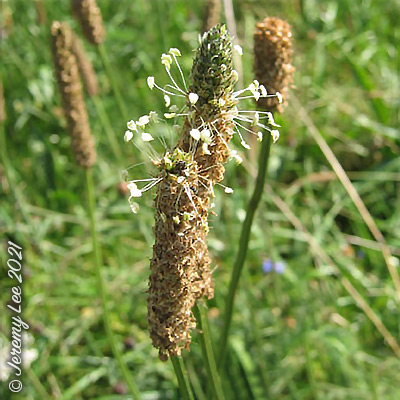
 |
|
Scientific Classifications explained » Amphibians » Ants » Aphids » Bees » Beetles » Birds » Bugs » Butterflies » Caterpillars » Damselflies » Dragonflies » Earwigs » Flies » Frog/Leafhoppers » Fungi » Galls » Grasshoppers » Harvestmen » Hoverflies » Lacewings » Ladybirds » Leaf Mines » Lichens » Mammals » Millipedes » Mosses » Moths » Sawflies » Slugs » Snails » Spiders » Trees » Wasps » Wild Flowers » Woodlice |
UK Nature > Wild Flowers > Green Wild Flowers > Plantago lanceolata

Scientific Name: Plantago lanceolata Common Name: Ribwort Plantain Plantago lanceolata, more commonly known as Ribwort Plantain, is a common perennial plant of arable fields and grassland, widespread throughout the UK on a range of soils. It may behave as a biennial or even an annual but is a true perennial with a thick short rhizome. Ribwort Plantain has spear-shaped leaves which form a rosette at the base of the plant. Short stems grow from its leaves, with compact heads and protruding, white stamens. The flower heads gradually turn brown and seed. It is a common roadside plant and flowers between April and October, but its seedheads remain for most of the winter providing food for Goldfinches and other seed-eating birds. |
|

https://www.uknature.co.uk is a website dedicated to showing the immense diversity of UK nature and wildlife. Our vast range of habitats, from lowland arable to snow covered mountains, from storm-ravaged coastlines to peaceful inland freshwater lakes and rivers, from dry, sandy heaths to deciduous and coniferous forests, all these habitats contribute to the abundance of UK nature. We have wild birds in huge numbers either residing or visiting our shores (597 recorded species as at July 2013) and we must also not forget the humble back garden with its grass lawns, flower beds filled with nectar rich flowers, shrubs and trees, all designed to attract huge numbers of insects such as bees, moths, butterflies and hoverflies; and finally the small ponds which provide safe havens for frogs, toads, newts and even slow worms and grass snakes. www.uknature.co.uk is the showcase for my personal passion, photographing uknature in all its glory. I sincerely hope you all enjoy the fruits of my labours. This site and all images contained therein is © Jeremy Lee 2004 - 2025. All Rights Reserved. Site design by Jeremy Lee. Site development & IT Support by Stuart Lee. |